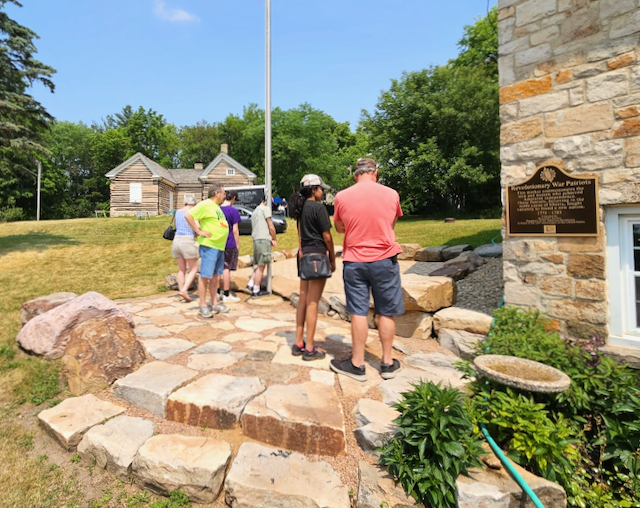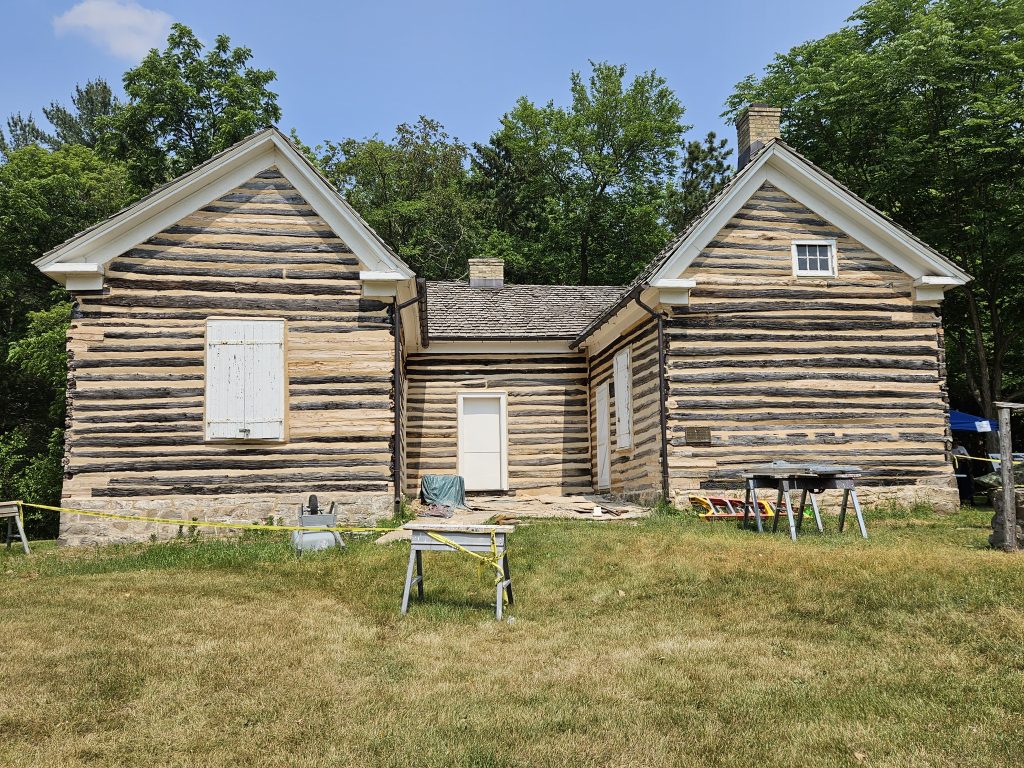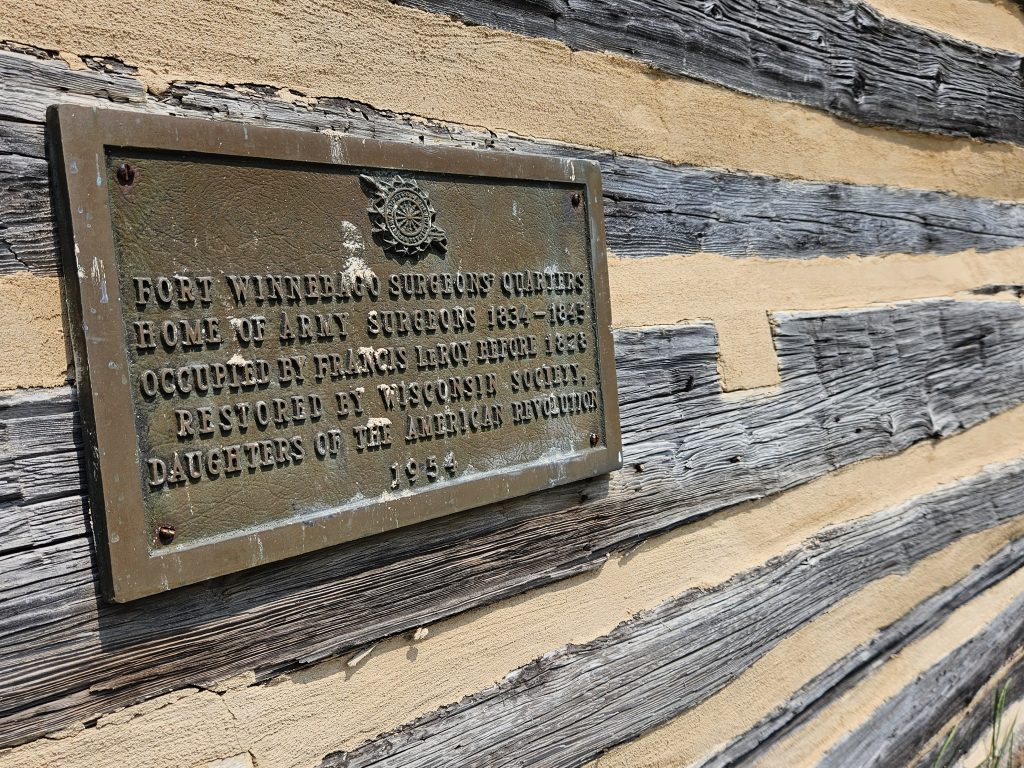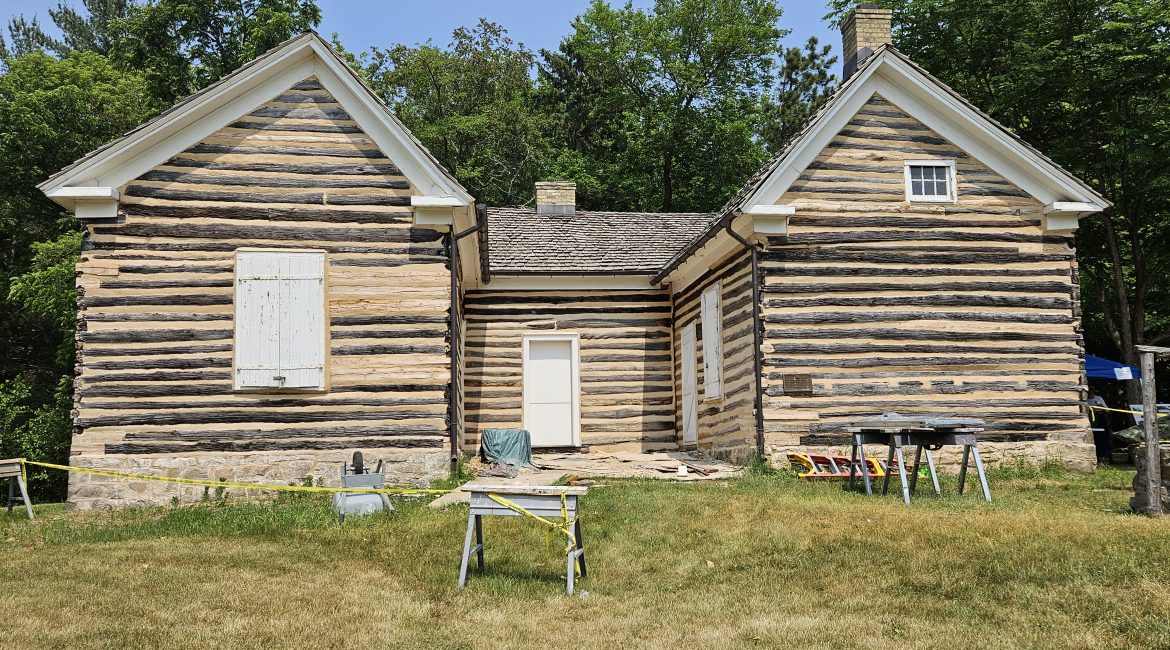By Chris Spangler
Many notables in Wisconsin’s — and even the nation’s — past have had ties to both Fort Winnebago and Fort Atkinson.
Located in Portage, Fort Winnebago was garrisoned in 1832 at the start of the Black Hawk War. It was built, however, three years earlier when a brief uprising known as the Winnebago War had taken place with a few attacks on American civilians by a portion of the Winnebago (now known as Ho-Chunk) tribe.
The Native Americans were reacting to a wave of lead miners trespassing on their lands and to false rumors that the United States had sent two Ho-Chunk prisoners to a rival tribe for execution.
This was when the government increased its military presence on the frontier, building Fort Winnebago and reoccupying two other abandoned forts.
The larger Black Hawk War involved many of the same people and concerned similar issues.
It was in June of 1831 that Black Sparrow Hawk and his small “British band” of Sauk and Fox Indians were forced out of Saukenuk, their home near Rock Island, Ill., and banished to Iowa.
Among difficulties faced in Iowa, historians say, the women had difficulty digging up the sod to plant corn. Black Hawk led the band across the Mississippi River back into Illinois on April 5, 1832, apparently hoping to reclaim land that was taken over by the federal government.
President Andrew Jackson ordered Brigadier General Henry Atkinson to pursue Black Hawk and force him back across the Mississippi River into the Louisiana Territory. Atkinson’s army of 3,500 troops and the Illinois militia chased the Native Americans up the Rock River, but could not locate them.
On July 6, 1832, the army camped on land located a couple miles southeast of what is today the city of Fort Atkinson in Jefferson County. It ran out of food, so the general dismissed unbrigaded units, including the Illinois militia, of which a young Abraham Lincoln was a member. (Fun fact: His horse, “Speedwell,” was stolen in the town of Cold Spring and he had to walk and hitch rides from fellow militiamen all the way back to Illinois.)
The rest of the army was sent to acquisition food. Atkinson ordered Col. Henry Dodge, who was in charge of the Michigan Territory or Wisconsin militia, to build a stockade to protect the supplies that soon would arrive. However, Dodge reportedly replied, “Sir, we did not come to build fortifications. We came to fight Indians,” so Atkinson sent Dodge and his squadron along with the other troops to procure food at Fort Winnebago near Portage.
This left only the U.S. Army Infantry under the command of Col. Zachary Taylor, and his troops built the stockade along the Rock River in four days. It was named Fort Koshkonong, later known as Fort Atkinson.
Back on Black Hawk’s trail, Dodge caught up with him on July 21, 1832, and defeated his band at the Battle of Wisconsin Heights. The Native Americans, made up of mostly old men, women and children, were weakened by hunger, death and desertion, and many native survivors retreated toward the Mississippi. On Aug. 2, 1832, soldiers attacked the remnants of the British band in the Battle of Bad Axe, killing many and capturing most who remained alive. Black Hawk and other leaders escaped, but later surrendered and were imprisoned for a year.
During the war, the U.S. Army did not have cavalry; the only mounted soldiers were part-time volunteers. After the Black Hawk War, Congress created the Mounted Ranger Battalion commanded by Dodge, which was expanded to the 1st Cavalry Regiment in 1833.
Who’s who?
So while a 23-year-old Abraham Lincoln, who would become the 16th U.S. president, was trudging home to Illinois, Col. Zachary Taylor, who would become the 12th president, was building Fort Koshkonong because Henry Dodge, who would become the first and last governor of the Wisconsin Territory, didn’t want to do it. Ironically, when Taylor was elected president in 1848, Dodge failed to become vice president on the “Barn Burners” ticket in the same election.
And by the way, after Aug. 27, 1832, when Black Hawk and Wabokieshiek, known as “The Prophet,” surrendered at Prairie du Chien to Indian agent Joseph Street, it was Col. Taylor who took custody of the prisoners and sent them by steamboat to Jefferson Barracks near St. Louis. He was escorted by Lts. Jefferson Davis and Robert Anderson.
Lt. Davis, of course, later became president of the Confederacy during the American Civil War. He served at Fort Winnebago after graduating from the U.S. Military Academy at West Point and took part in Black Hawk’s pursuit through the Fort Atkinson area.
Many other familiar names were on the army’s rosters. Major David Twiggs was a career army officer who, in 1828, was sent to Wisconsin to establish Fort Winnebago at the portage between the Fox and Wisconsin rivers. This was a base of operation during the Black Hawk War.
Randolph B. Marcy graduated from West Point and was assigned as a lieutenant in the infantry. Right away, he saw combat in the Black Hawk War, and he eventually was stationed at Fort Winnebago from 1837-40. Marcy later became chief of staff to his son-in-law, Gen. George McClellan, during the Civil War.
Edwin “Bull” Vose Sumner was a career army officer who became a Union army general and the oldest field commander of army corps on either side during the Civil War. Decades earlier, though, he was stationed at Fort Winnebago and fought in the Black Hawk War.
Then there was John Joseph Abercrombie, who graduated from West Point in 1822 and became the adjutant of the 1st U.S. Infantry. He was promoted to first lieutenant in September 1828, serving in the Black Hawk War. He then was on garrison duty in Illinois and Wisconsin.
Also worthy of mention was Dr. Benjamin F. Harney, an Army surgeon who served in the 1st Infantry. He began his many years of interactions with Native Americans on the Great Plains in 1825, when he accompanied then-Col. Henry Atkinson and Benjamin O’Fallon on an expedition to sign treaties with the Upper Missouri tribes. In 1832, Harney fought in the Black Hawk War, serving as Gen. Taylor’s assistant inspector. It was there he met and befriended Jefferson Davis, Taylor’s son-in-law and a fellow army officer.
On July 21, 1832, Capt. Gideon Low, commander of Company D, 5th Infantry Regiment, was placed in command of Fort Koshkonong and in charge of provisions as Atkinson trailed Black Hawk toward Blue Mounds. He and his soldiers remained there until Sept. 26, 1832. Six years later, Low was put in command of Fort Winnebago.
In 1839, he left the army and settled at Fort Winnebago. Low reportedly was Columbia County’s first farmer and proprietor of the Franklin House at Portage until his death in 1850.
Forts’ finale
And now one final connection between Fort Winnebago and Fort Atkinson.
From 1818-23, John Kinzie worked for the American Fur Company. He then was employed a while for the Michigan Territory governor in the 1820s before becoming the sub-agent for Indian affairs at Fort Winnebago. He lived at the Indian Agency House and returned to Chicago in 1833.
His wife, Juliette Kinzie, was the first woman of European descent to set eyes on Lake Koshkonong, just south of Fort Atkinson. She, John, and others were traveling back to Fort Winnebago from a visit to Chicago in the spring of 1831.
Overlooking the shore, they saw Maneater’s Village, home of a Winnebago settlement located on the east side of the Rock River where it enters Lake Koshkonong on the south.
“Maneater’s Village … a collection of the neat bark wigwams, with extensive fields on each side of corn, beans and squashes recently planted, already giving promise of a fine crop,” she wrote. “In front was a broad blue lake, the shores of which to the south were open and marshy, but near the village and stretching far away to the north were bordered by fine lofty tress.”
Growing up as a New England socialite, Kinzie wrote a book titled: “Wah-Bun: The Early Days in the Northwest,” an important first-person account of life on the frontier. She became a well-known historian, civic leader and best-selling author.
The Kinzies’ granddaughter became a notable in her own right: Juliette Gordon Low founded the Girl Scouts of America in 1912.
A story about more modern ties between Fort Atkinson and Fort Winnebago is here: https://fortatkinsononline.com/heat-beat-repeat-fort-teacher-returns-blacksmithing-to-its-roots/.

Visitors to the Fort Winnebago Surgeons Quarters view patio bricks remembering patriots who fought for the colonists in the American Revolutionary War.

The Fort Winnebago Surgeons Quarters, Portage.

Information found on the Fort Winnebago Surgeons Quarters notes that the building was the “home of Army surgeons 1834-1845,” and was “occupied by Francis LeRoy before 1828.” The building was restored in 1954 by the Wisconsin Society, Daughters of the American Revolution.
Chris Spangler photos.
This post has already been read 5019 times!

Andrew Jackson’s role in selecting southern military personnel to fight Americans in Wisconsin could be explored further. The reference to the “British band” demonstrates the bias of the writer, since the British were long gone from American soil.
The British had lost the war of 1812. However, it is correct that Blackhawk had sought and thought he had secured British support to fight the Americans. The premise was that the British would supply ammunition and even troops who would join with a range of different Indian tribes to counter the Americans.
I have enjoyed your online paper’s continued progress. Congratulations on the new Whitewater site too. Your recent article on the Fort Atkinson and Fort Winnebago connection caught my eye. I am a history buffer regarding the local area and have many reference volumes. One of the more extensive is the Illinois Historical Society four volume set and I would recommend it to others because it contains copies of hundreds of original source documents.
One comment at the beginning of your story that should be corrected or expanded upon is that Blackhawk’s band moved to return to some land east of the river because the women found the relocation area soil difficult to till for corn. I can’t confirm or refute that point. However, it was NOT the major reason for the return to the land taken by treaty. It is important to know that the whole war could have been avoided and the hundreds and hundreds of lives lost by simply providing about 20 acres of the land just east of the river back to the tribe. You see, it was an ancestral burial ground. It had meaning to them like would destroying the local cemeteries to us today. Blackhawk had visited the burial ground and found the settlers had grabbed the land and were plowing it; a real transgression to honoring the spirits of the dead. This, rather than corn cultivation, was the major trigger of the war. Had this 20 acre area been protected and people allowed to return to visit it the likelihood the war would have been avoided.
By the way, if you are looking for the old storage stockade that is the “Fort”, I would look from about the end of East Street down toward the Rock-Bark junction. Having grown up in that area I would routinely find things buried which seemingly might have evidenced some crude foundation elements aimed to stabilize the stockade base vertical logs.
Here is that reference set if anyone is looking…
https://www.abebooks.com/9780912154206/Black-Hawk-1831-1832-Collections-Illinois-0912154209/plp
Thanks, Emmons. The additional information is very helpful. The reference material also is much appreciated — K.